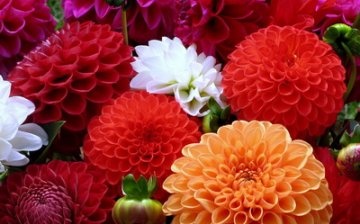Dahlias - photo, cultivation and care
Dahlias, photos of which can be seen so often today in gardeners' photo albums, in their wild form in India were previously used for food. The Indians did not eat the flowers themselves or their leaves and stems, but the tubers of these flowering plants.
In Europe, since 1787, this beautiful flower began to be used for decorative purposes, decorating flower beds with it in their gardens, planting in massifs or group plantings.
Give your dahlias a well-sunlit place, protected from wind blowing, but with good air circulation, and they will delight you with lush and bright blooms. At least these plants should receive six hours of sun per day.
In lowlands, on highly waterlogged soil, dahlias should not be grown. If you do not have a normal place in the garden, then you will have to raise the level of the flower beds for planting dahlias.
It is recommended to loosen the soil around the dahlia bushes after each watering, make sure that there are no weeds. When buds form on the plants, loosening is stopped and the soil is mulched with peat or humus.
In order for dahlias to bloom magnificently, the photos of which will later delight you in albums, you need to form their bushes. It is necessary, firstly, to break out the side stepchildren in the leaf axils, and, secondly, to remove those shoots that grow from the root collar. If this is neglected, flowering will begin with a strong delay and will be weaker.
Around October, you will need to start harvesting dahlia tubers for winter storage. The best place for wintering will be basement conditions with a temperature of + 4-8 degrees. You can place the tubers in slightly damp sand or peat.






